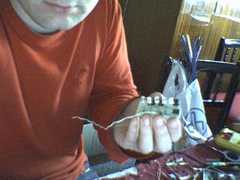donut
|
| posted on 26/5/06 at 09:32 PM |

|
|
I must say that was the fastest growing thread i have ever seen!!
Andy
When I die, I want to go peacefully like my Grandfather did, in his sleep -- not screaming, like the passengers in his car.
http://www.flickr.com/photos/andywest1/
|
|
|
|
|
BKLOCO
|
| posted on 26/5/06 at 09:32 PM |

|
|
quote:
Originally posted by CaLviNx
Hi
Looks cool, you got a parts list and circuit boards layout drawing ?
Regards
All parts available from RS for under a fiver.
I'll wait until its a goer on the car then post details for anyone who is interested.
Experience is what you get when you don't get what you want!!! 
|
|
|
BKLOCO
|
| posted on 27/5/06 at 02:03 AM |

|
|
A 20 LED, or for that matter any, air fuel ratio gauge running from a narrow band sensor will be as good as useless as a tuning aid.
The reason is that a narrow band sessor will tell you if your mixtue is rich, lean or at 14.7:1 What it will not do is give you reliable indications
of how weak or lean it is. The slope of the graph is just too steep and not linear enough. Plus the readings at high revs and low MAP will be
useless.
An indicator consisting of 3 LEDs would give you as much information as one with 20.
ie. Lean - OK - Rich.
With a wide band sensor you must use a controller such as the innovate LC-1 to drive the sensor . This you can calibrate to give you whatever output
you desire. eg. 0 - 5 volts = lambda of 0.5 - 1.5.
This is the default output 2 setting of the Innovate controller.
I will re-calibrate the output to give me 0 - 5 volts but at a changed lambda value of 0.7 - 1.3. The reason for this is that it is unlikely that you
would be running in the very weak or very lean areas that often. Even when you are, that information is not particularly relevent. eg. on overrun. It
is therefore more usefull to expand the readings in the area which you will be running most of the time.
Your gauge will help you get your carbs near for the purposes of idle settings, emissions settings and to a limited extent cruise mixture but that
will be its limit.
You will not be able to tune acceleration enrichment for example as it will not be accurate enough to tell you how rich you are.
Experience is what you get when you don't get what you want!!! 
|
|
|
tks
|
| posted on 27/5/06 at 08:16 AM |

|
|
mhhh
Who said shift lights??
You see in the picture 5 leds...
the scale will be as follows:
the outer ones are Yellow, 4Krpm.
Then comes Green 6Krpm..
then the middle one will be orange 8Krpm..
then when hitting 10K all of them will start flashing, sow you now when it flashes you need to upshift....
its the same as in the F1.. they have it on their steering wheel..
Regards,
Tks
it senses its rpm from the negative side of the coil.
[Edited on 27/5/06 by tks]
 
Rescued attachment shiftlights.JPG
The above comments are always meant to be from the above persons perspective.
|
|
|
Krismc
|
| posted on 27/5/06 at 08:34 AM |

|
|
and you have drawings for that shift light set up!!
I fancy making that!!
Built, Ivaed, Drove and now Sold - 2011 MNR VORTX RT+ 2000cc Zetec on R1 Throttle boddies.
|
|
|
tks
|
| posted on 27/7/06 at 09:09 AM |

|
|
well
mine only needs a coil.
i used this:
- Pic16F819
- 5 bright leds in their colors
- 1 4N25 (opto coupler)
- 2 10K res
- 1 zener 5volts
- 1 normal diode
- 1 218ohms res
- 1 7805
- 1 1uF cap
- 2 small caps 0,05uf
the pic does the hardwork since they are free and this model is taken because of the built in OSC.
its no really developped but it works if the zener is changed for one with 24volts.
the caps could be eliminated altough teh 218res should maybe be higher
The above comments are always meant to be from the above persons perspective.
|
|
|













